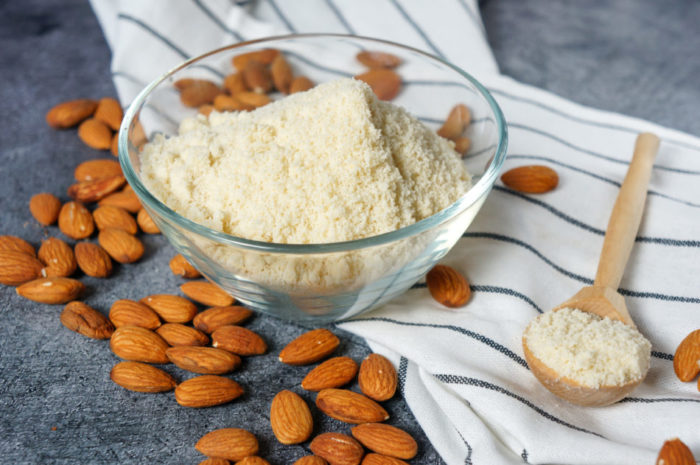Flour is the heart and soul of several recipes, especially baking recipes. All purpose flour has been the most popular choice for most of these purposes for a very long time. However, in the modern world, there is an entire crop of options and flours that you can use to match your taste and diet preferences.
One of these options is almond flour, which is somewhat more expensive than all-purpose flour. However, its key features make almond flour a desirable pick for several recipes and uses. So, let’s see where things stand in the almond flour vs all purpose flour comparison
Almond flour is often seen as a healthier option, while all purpose flour is more versatile. And, of course, there’s a difference in their origin and specific uses of these wonderful flours.
Almond Flour vs All Purpose Flour: Key Points
Origins – What Is Almond Flour And What Is All Purpose Flour?

Almond flour comes from blanched almonds. The process involves boiling almonds in water, which helps remove their skin. After this, almonds undergo grinding and sifting to get into a powdery form and have a consistency similar to flour.
The production of all purpose flour is more involved, complex, and involves some chemical processes.
This is a reason why all purpose flour is also known as refined flour. The manufacturing process involves removing the brown covering from wheat grains. After this, the grains are ground, refined, and bleached. Once this process is done, the all-purpose flour is ready.

Nutrients And Allergens
Almond flour is gluten-free. It’s also impressively low in carbs. A cup of almond flour will have only about 24g of carbohydrates. As for the calorie count, it’s well understood that almonds carry a lot of calories.
A cup of almond flour will carry 450 to 650 calories. Similarly, you can expect a higher fat content in almond flour. A cup of almond flour has about 56 grams of fat, which is exponentially more than the fat in all purpose flour. Almond flour contains about 50% more protein than all purpose flour.
Other notable nutrients in almond flour include proteins, fiber, magnesium, and Vitamin E. Since almond flour is basically almonds, its nutrient profile matches this famous fruit.
All purpose flour is sourced from wheat and thus contains gluten. It also has a significantly higher carbohydrate content; you can expect each cup of all purpose flour to contain 95 grams of carbs. Interestingly, the fat content here is negligible, with only 1.2 grams showing up in a cup of flour. All purpose flour doesn’t offer much by way of nutrients.
Packaging And Storage
Almond flour has a relatively low shelf life. You can expect it to last a couple of months in the pantry or about six months when placed in a refrigerator.
All purpose flour fairs much better in this regard. During its manufacturing and processing, most of the oil is removed from the kernel. This reduces the risk of spoilage of the flour, thus allowing it to last longer. Most all purpose flour can last up to a year in the refrigerator or about eight months in the pantry.
The Taste Equation
All purpose flour has a very mild taste, veering towards the neutral. This property makes it a good choice as a cooking ingredient, since it’s more convenient to work with flavors and move it towards your taste preferences.
Almond flour has that distinct, nutty taste of almonds with some sweetness. When working with this flour to make a dish, you’ll have to remember to account for the taste of almonds in the recipe. Of course, there are many ways to make the best of this characteristic and get a wonderful flavor from your almond flour.
Practical Uses – Baking, Cooking, And Rise
All purpose flour is pretty versatile and finds use in a range of recipes and cuisines. It really can live up to its name and can find use in a whole range of dishes.
Almond flour is more restricted in its use and is often mixed with other ingredients to set it up. It’s most commonly used in baking, but extra care must be exercised.
Since there is plenty of fat and no gluten in this flour, it needs a binding agent to keep it together. Additionally, you need a way to deal with the high fat content, because otherwise the baked goods might end up looking messy and greasy.
Often, protein powder or eggs play this role. Eggs can act as a remarkable binding agent, while absorbing the moisture (fat) released by almond flour during baking.
All purpose flour is easy to work with and creates a wonderful texture and structure for the recipe. Almond flour is heavier and creates denser products.
FAQ
Can Almond Flour Be Substituted For All Purpose Flour?
For most recipes, it isn’t a good idea to replace almond flour for all purpose flour. To be clear, it is possible to make the replacement, but you’ll have to do a fair amount of work to make it happen, and be prepared for the change in the texture and taste of the dish.
The presence of gluten is an important aspect of all purpose flour (and for all wheat flours). It works as a binder and helps give recipes structure. Because of the low amount of fat, the flour doesn’t have to make allowances for managing fat and moisture.
Once the high-fat and denser almond flour gets into this action, it is bound to change the resulting recipes, even with adjustment. You’ll also have to consider the flavor almond flour brings to the recipe.
All things considered, it may not be the best course of action to replace all purpose flour with almond flour.
Is Almond Flour Better Than White Flour?
Whether you find almond flour to be a better choice than white flour depends on the goal you want to accomplish. If your requirement is a gluten-free and nutritious flour, almond flour can definitely fit the definition. But remember, it has high fat content and needs additives to bind the flour together and absorb the fat and moisture during cooking.
On the other hand, white flour is remarkably easy to work with. It’s light and helps give structure to baked dishes. It’s also very versatile and can find use with a whole range of recipes. However, it is high in carbs, low in fat, and doesn’t contain any notable nutrition. White flour also undergoes chemical processes like bleaching, which don’t inspire confidence in its nutritional or healthy use.
How Many Carbs In Almond Flour?
Almond flour is impressively low in carbohydrates. One cup of almond flour contains only 24 grams of carbohydrates, which is significantly lower than many of its counterparts. For comparison, a cup of all purpose flour can contain 95 g of carbs
Is Almond Flour Healthy?
It is possible to consider almond flour as a healthy option. It contains many nutrients like proteins, fiber, magnesium, and Vitamin E. It’s worth noting that the flour is low in carbohydrates and includes a significant amount of fats.
Is Almond Flour Gluten Free?
Almonds do not contain gluten and since almond flour is sourced straight from almonds, it doesn’t contain any gluten either. So yes, almond flour is gluten-free. Still, it’s a good idea to check the ingredient list before you buy to be sure.
Pure almond flour is naturally gluten-free, manufacturers might add other products to this flour. Similarly, it may be produced in a factory or machinery that also handles conventional flour. As such, reading the label can help you be sure that you’ve made the right choice.
Conclusion
In a comparative study of almond flour vs all purpose flour, we see that both these options have interesting characteristics. They’re quite interesting and exhibit unique properties in most aspects. This includes their use in cooking as well as their nutrition content.
Though these flours are hugely different from each other, they can occasionally have overlaps. Yet, it’s always a good practice to keep allergens in mind. All purpose flour contains gluten, while almond flour is naturally gluten-free.
